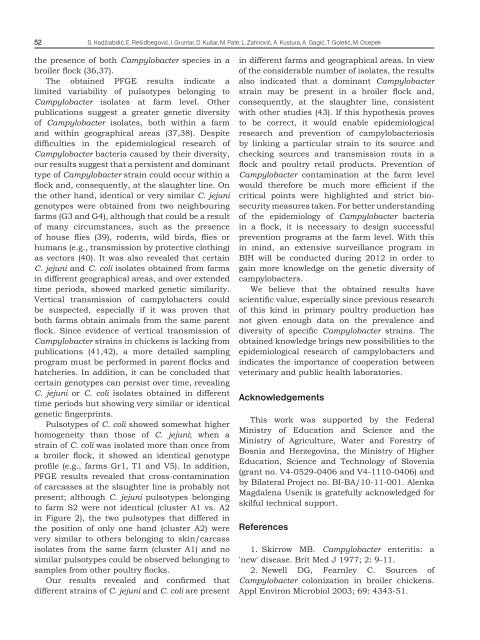SLOVENIAN VETERINARY RESEARCH
SLOVENIAN VETERINARY RESEARCH
SLOVENIAN VETERINARY RESEARCH
- No tags were found...
You also want an ePaper? Increase the reach of your titles
YUMPU automatically turns print PDFs into web optimized ePapers that Google loves.
52S. Hadžiabdić, E. Rešidbegović, I. Gruntar, D. Kušar, M. Pate, L. Zahirović, A. Kustura, A. Gagić, T. Goletić, M. Ocepekthe presence of both Campylobacter species in abroiler flock (36,37).The obtained PFGE results indicate alimited variability of pulsotypes belonging toCampylobacter isolates at farm level. Otherpublications suggest a greater genetic diversityof Campylobacter isolates, both within a farmand within geographical areas (37,38). Despitedifficulties in the epidemiological research ofCampylobacter bacteria caused by their diversity,our results suggest that a persistent and dominanttype of Campylobacter strain could occur within aflock and, consequently, at the slaughter line. Onthe other hand, identical or very similar C. jejunigenotypes were obtained from two neighbouringfarms (G3 and G4), although that could be a resultof many circumstances, such as the presenceof house flies (39), rodents, wild birds, flies orhumans (e.g., transmission by protective clothing)as vectors (40). It was also revealed that certainC. jejuni and C. coli isolates obtained from farmsin different geographical areas, and over extendedtime periods, showed marked genetic similarity.Vertical transmission of campylobacters couldbe suspected, especially if it was proven thatboth farms obtain animals from the same parentflock. Since evidence of vertical transmission ofCampylobacter strains in chickens is lacking frompublications (41,42), a more detailed samplingprogram must be performed in parent flocks andhatcheries. In addition, it can be concluded thatcertain genotypes can persist over time, revealingC. jejuni or C. coli isolates obtained in differenttime periods but showing very similar or identicalgenetic fingerprints.Pulsotypes of C. coli showed somewhat higherhomogeneity than those of C. jejuni; when astrain of C. coli was isolated more than once froma broiler flock, it showed an identical genotypeprofile (e.g., farms Gr1, T1 and V5). In addition,PFGE results revealed that cross-contaminationof carcasses at the slaughter line is probably notpresent; although C. jejuni pulsotypes belongingto farm S2 were not identical (cluster A1 vs. A2in Figure 2), the two pulsotypes that differed inthe position of only one band (cluster A2) werevery similar to others belonging to skin/carcassisolates from the same farm (cluster A1) and nosimilar pulsotypes could be observed belonging tosamples from other poultry flocks.Our results revealed and confirmed thatdifferent strains of C. jejuni and C. coli are presentin different farms and geographical areas. In viewof the considerable number of isolates, the resultsalso indicated that a dominant Campylobacterstrain may be present in a broiler flock and,consequently, at the slaughter line, consistentwith other studies (43). If this hypothesis provesto be correct, it would enable epidemiologicalresearch and prevention of campylobacteriosisby linking a particular strain to its source andchecking sources and transmission routs in aflock and poultry retail products. Prevention ofCampylobacter contamination at the farm levelwould therefore be much more efficient if thecritical points were highlighted and strict biosecuritymeasures taken. For better understandingof the epidemiology of Campylobacter bacteriain a flock, it is necessary to design successfulprevention programs at the farm level. With thisin mind, an extensive surveillance program inBIH will be conducted during 2012 in order togain more knowledge on the genetic diversity ofcampylobacters.We believe that the obtained results havescientific value, especially since previous researchof this kind in primary poultry production hasnot given enough data on the prevalence anddiversity of specific Campylobacter strains. Theobtained knowledge brings new possibilities to theepidemiological research of campylobacters andindicates the importance of cooperation betweenveterinary and public health laboratories.AcknowledgementsThis work was supported by the FederalMinistry of Education and Science and theMinistry of Agriculture, Water and Forestry ofBosnia and Herzegovina, the Ministry of HigherEducation, Science and Technology of Slovenia(grant no. V4-0529-0406 and V4-1110-0406) andby Bilateral Project no. BI-BA/10-11-001. AlenkaMagdalena Usenik is gratefully acknowledged forskilful technical support.References1. Skirrow MB. Campylobacter enteritis: a'new' disease. Brit Med J 1977; 2: 9-11.2. Newell DG, Fearnley C. Sources ofCampylobacter colonization in broiler chickens.Appl Environ Microbiol 2003; 69: 4343-51.
















